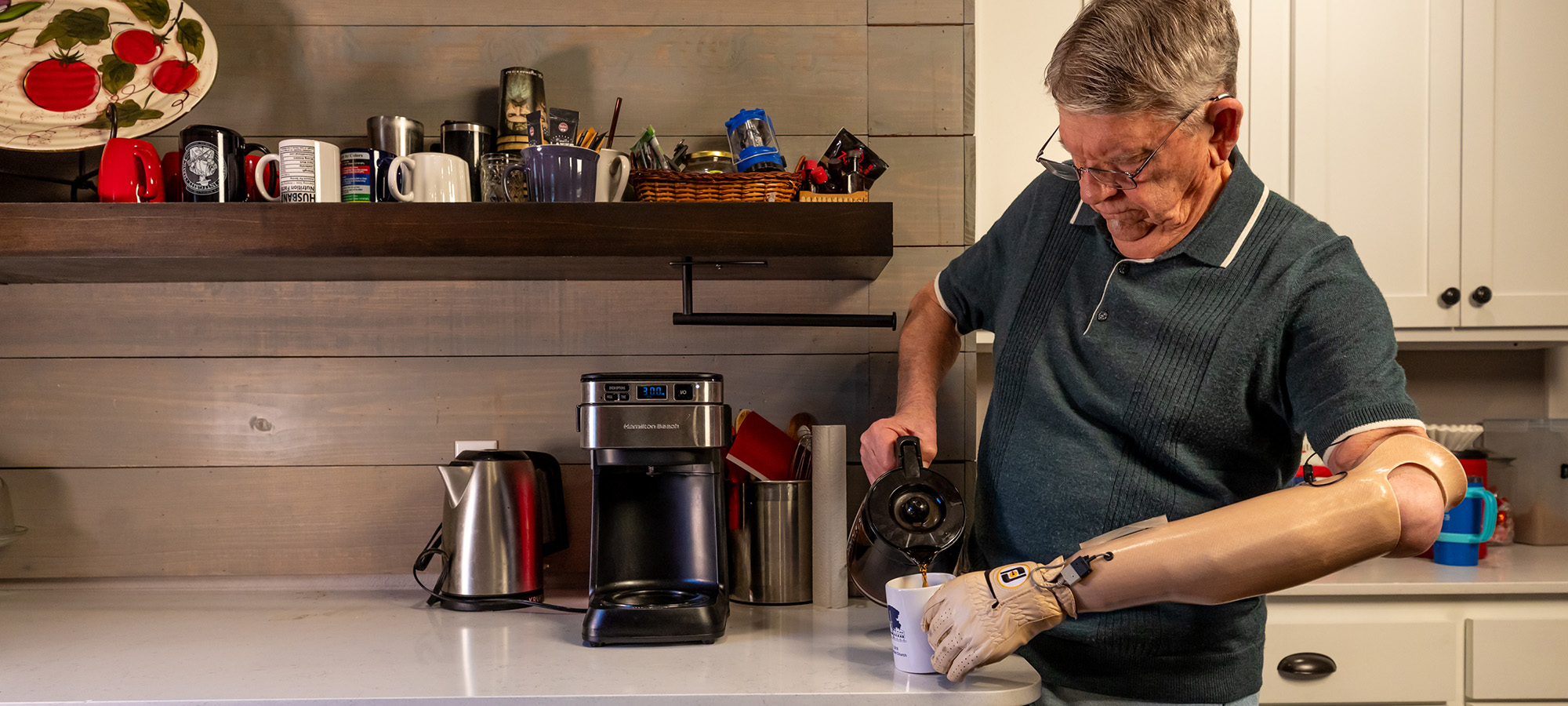
RESTORING TOUCH
Delivering Feeling from Artificial Limbs
When Dewey Hickey was in the fourth grade, he broke his arm in a bicycle accident. Unbeknown to Hickey’s doctors, a piece of bone fragment also cut a nerve.
“My left arm deteriorated while it was in the cast to the point that there was nothing left,” Hickey explains. “The tendons, the blood supply, the muscle, everything in the front of my arm was gone. And so I wound up with a crippled hand at 10 years of age.”
Fourteen years after his accident, Hickey had his hand amputated and has used a series of prosthetics since then.
The one he utilizes now – a neural enabled prosthetic hand system pioneered by the Institute for Integrative and Innovative Research (I³R) at the University of Arkansas – is unlike the others he has used in the past. It’s an innovative investigational device that has not only restored a sense of touch for Hickey but a sense of hope as well.
“This prosthetic is not comparable to any of the prosthetics I’ve had in the past – and I have had three of them over the last 60 years,” Hickey says.
Hickey is the first Arkansan and only the second person in the world to receive the novel prosthetic device, which has the potential to restore a meaningful sense of touch and grip force to individuals with an upper limb amputation.
“All of us need to connect with the environment,” says Ranu Jung, U of A associate vice chancellor, founding executive director of I³R and distinguished professor of biomedical engineering. “Touch is central to how we experience and connect with our environment and with other people. This project gives a pathway to restore that sense of touch and wholeness to that person.”
THE HEART BEHIND THE HEALING
“As I look back on it now, I felt different than other kids,” Hickey says. “I felt a little bit ashamed that I had one hand missing. It wasn’t something that came from birth. It was something that happened to me that changed me. And I didn’t particularly like the change, and I didn’t admit that that changed me in any manner until just a few years ago.”
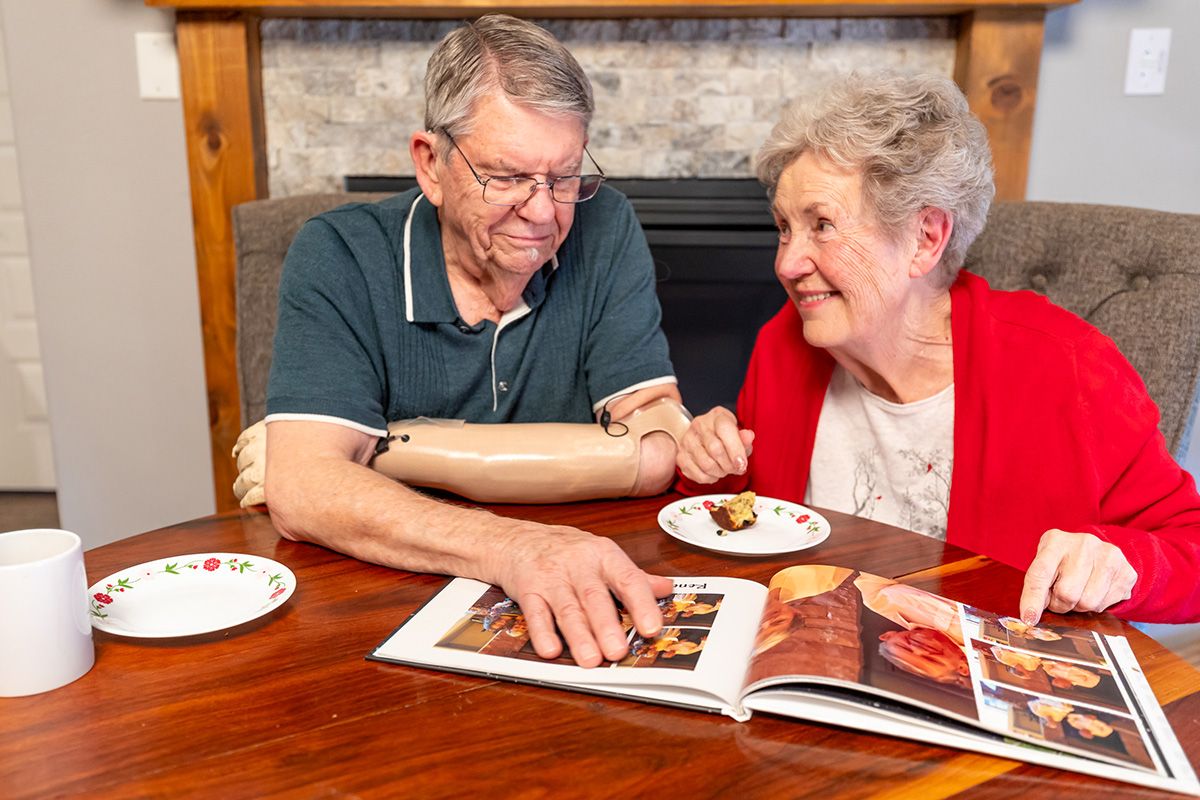
Hickey is part of an ongoing clinical trial of the novel prosthetic hand system, which has been approved by the Food and Drug Administration for investigation. The project is supported by grants from the U.S. Army from the Department of Defense and the National Institute of Biomedical Imaging and Bioengineering of the National Institutes of Health.
Jung explains that the prosthesis project restores well-being to a person who has lost their upper limb. “When you lose an upper limb, you might get a myoelectric prosthesis, and you might be able to use that to hold and move things,” she says. “But you don’t feel anything.”
James Abbas, professor of biomedical engineering with I³R and principal investigator along with Jung, further explains that instead of just controlling the opening and closing of a hand, their prosthetic allows someone to actually feel what’s touching the hand as well.
“The hand is gone, but the nerves are still there,” he says. “And if we stimulate those nerves, then that information goes up to the brain the same way it used to, and the person feels it as if it’s coming from their fingertips.”
 To prepare Hickey for his new neuroprosthetic system, a team of surgeons from the
University of Arkansas for Medical Sciences, trained by the I³R team on the specific
surgical technique, implanted 15 microelectrodes into the nerves of his arm to help
facilitate communication with the prosthesis.
To prepare Hickey for his new neuroprosthetic system, a team of surgeons from the
University of Arkansas for Medical Sciences, trained by the I³R team on the specific
surgical technique, implanted 15 microelectrodes into the nerves of his arm to help
facilitate communication with the prosthesis.
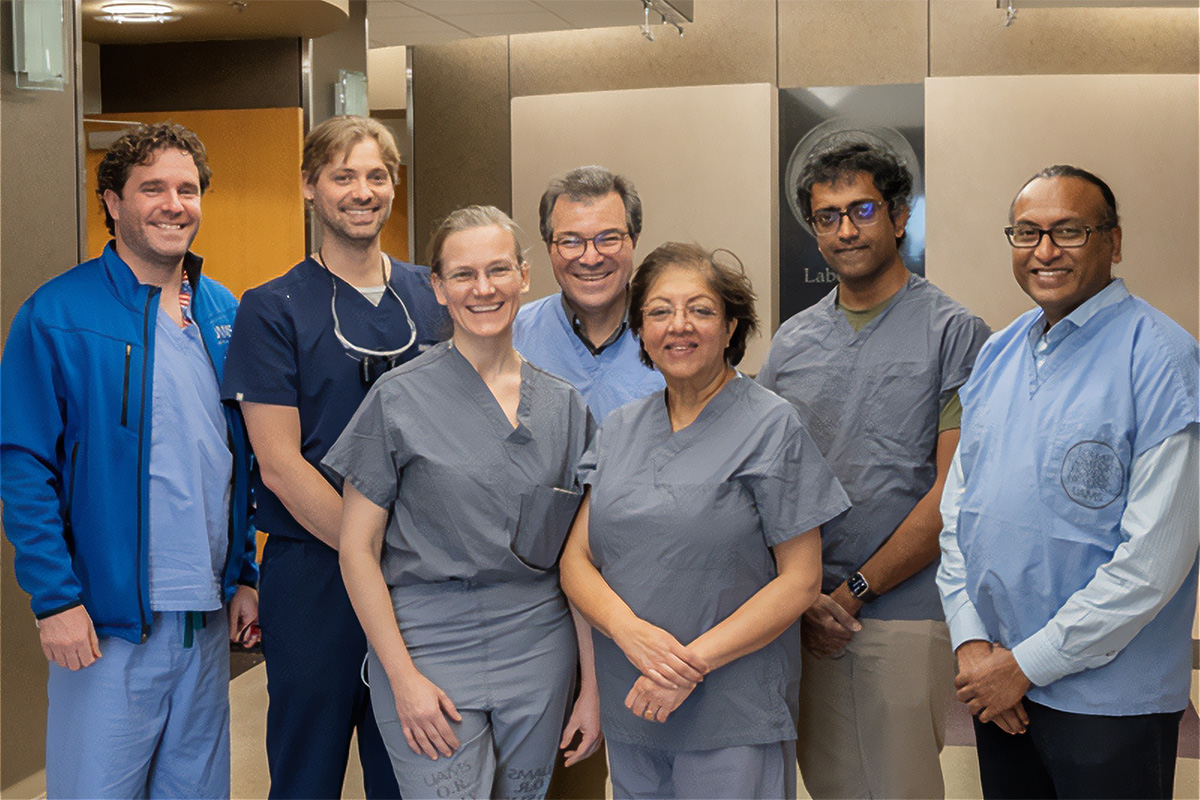
Ultimately, Abbas says, they want users to be able to utilize the system at home. It’s one thing to see how the technology performs in the lab, but it’s another to see it help individuals in their everyday lives.
“If it’s going to take them half an hour to set up our system…it’s not going to happen,” he says. “It’s not going to be useful to them, and we can’t add that burden on to someone every day. We want it to be easy to use.” For Hickey, wearing and setting up the prosthesis that enables him to feel is just about as easy as wearing his other prosthesis – it takes less than a minute.
Hickey says his experience working with the I³R research group at the University of Arkansas has been “phenomenal.” He was expecting a very scientific approach, but he didn’t anticipate the support and care that would go into his engagement.
“I ran into a group of people that were probably as sensitive as anybody I’ve ever worked with in my life,” he says. “They were always concerned about me and where I was, and I was shocked at that.”
DRIVEN BY PURPOSE
As I³R’s clinical trial progresses, so too does interest in the expansion of the project. In addition to its collaboration with the University of Arkansas for Medical Sciences, I³R announced a collaboration with Walter Reed National Military Medical Center in August 2023, which will be funded through a $4.9 million grant from the Department of Defense Joint Warfighter Medical Research Program. Thanks to this expansion, Walter Reed will now be used as a second site for the clinical trial and expands it to U.S. service members and their dependents.
I³R’s current research projects – which also include innovations in augmented and virtual reality and sustainable food systems – fall under their umbrella of Integrative Health, the initial Grand Challenge of the institute.
Jung says, “I³R is driven by purpose. We want to find solutions for wicked problems, and for this we go through the process of discovery, development of a solution, delivery of that solution and deployment of that solution so that we can impact the lives for whom we are developing the solution.
“Research excellence – with an emphasis on deployment – is what puts us in the forefront of providing solutions to our own community, to our region and our world.”
A “wicked problem” is something that’s difficult or seemingly impossible to solve because of differing, contradictory or incomplete requirements.
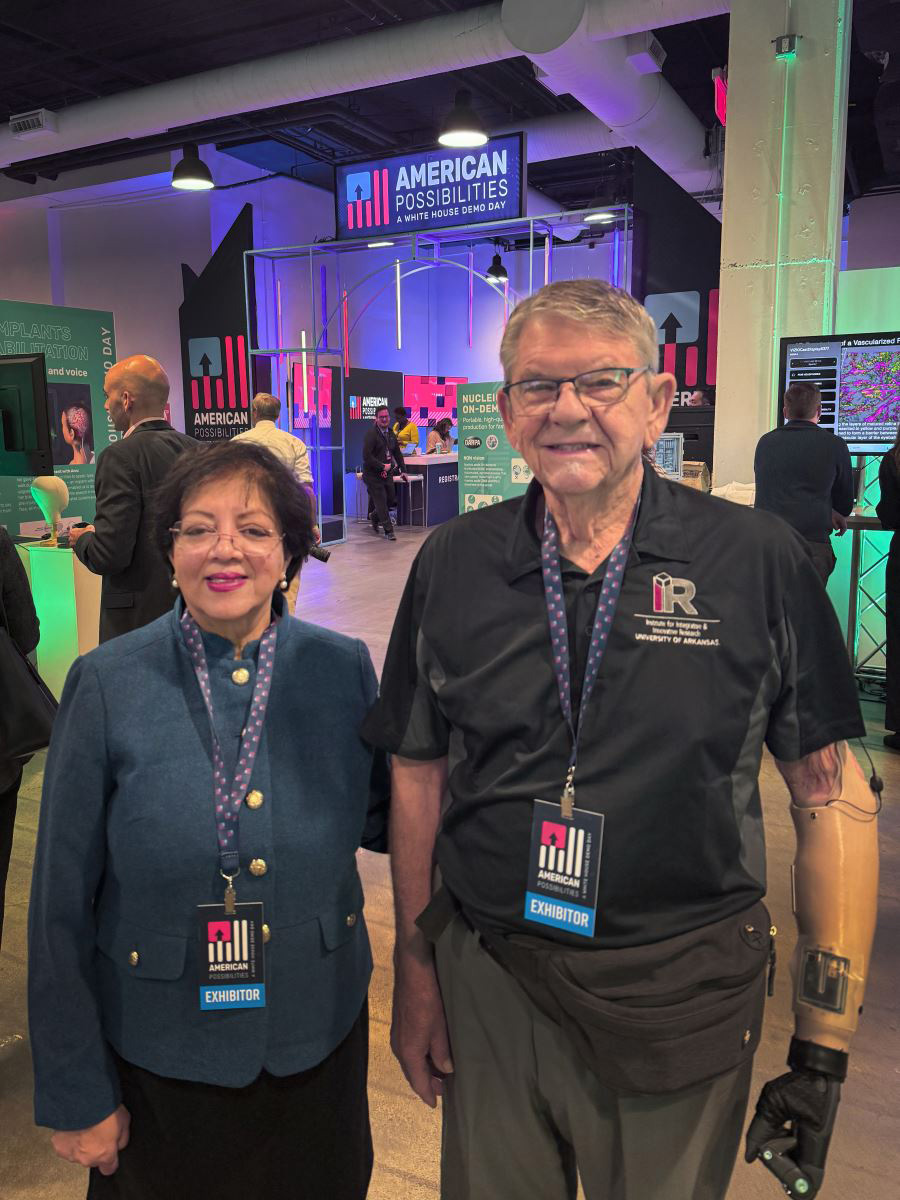
This research bolsters the U of A’s national science and technology capabilities and demonstrates the multitude of opportunities that exist in Arkansas. As someone who has lived in Arkansas nearly his entire life, Hickey says it makes him proud of his state – and the state’s flagship university.
“I never dreamed that I would be involved in something like this,” Hickey says. “I think it’s great that Arkansas is the place where this is located right now, and it certainly makes it accessible to me.”
In discussing Hickey’s involvement, both Jung and Abbas are quick to point out that their research and development would not be possible without the commitment and dedication of people like Hickey. “As engineers and clinicians, we can create technology,” says Abbas, “but it will only be useful if we get input and insights from pioneers like Mr. Hickey, who are willing to commit to making it happen.”
 The Institute for Integrative and Innovative Research was established through a
landmark gift from the Walton Family Charitable Support Foundation.”
The Institute for Integrative and Innovative Research was established through a
landmark gift from the Walton Family Charitable Support Foundation.”
FEELING IS BELIEVING
Jung notes that there’s considerable long-term potential for the neural-enabled prosthetic hand system, because the technology itself is a platform. It’s a technology that allows for the stimulation of specific nerves for selective stimulation that could ultimately impact what they refer to as “bioelectronic medicine.”
“The impact of the system is not only on the person’s physical capabilities but also on their emotional and mental well-being,” Jung says. “Imagine being able to touch and feel something—the emotion you get from holding a loved one’s hand, touching a child’s face or sensing the texture of an object. Touch and feeling are how we connect to and engage with our environment. It gives us emotional satisfaction and also impacts our mental health.”
Hickey admits that during the trial, he’s had both exciting and frustrating moments with his own environment – and readjusting to the idea of having sensation and grip control in both hands. “I am having to learn that I actually have the possibility of a left hand to do something with, after that many years of not having a left hand,” he says.
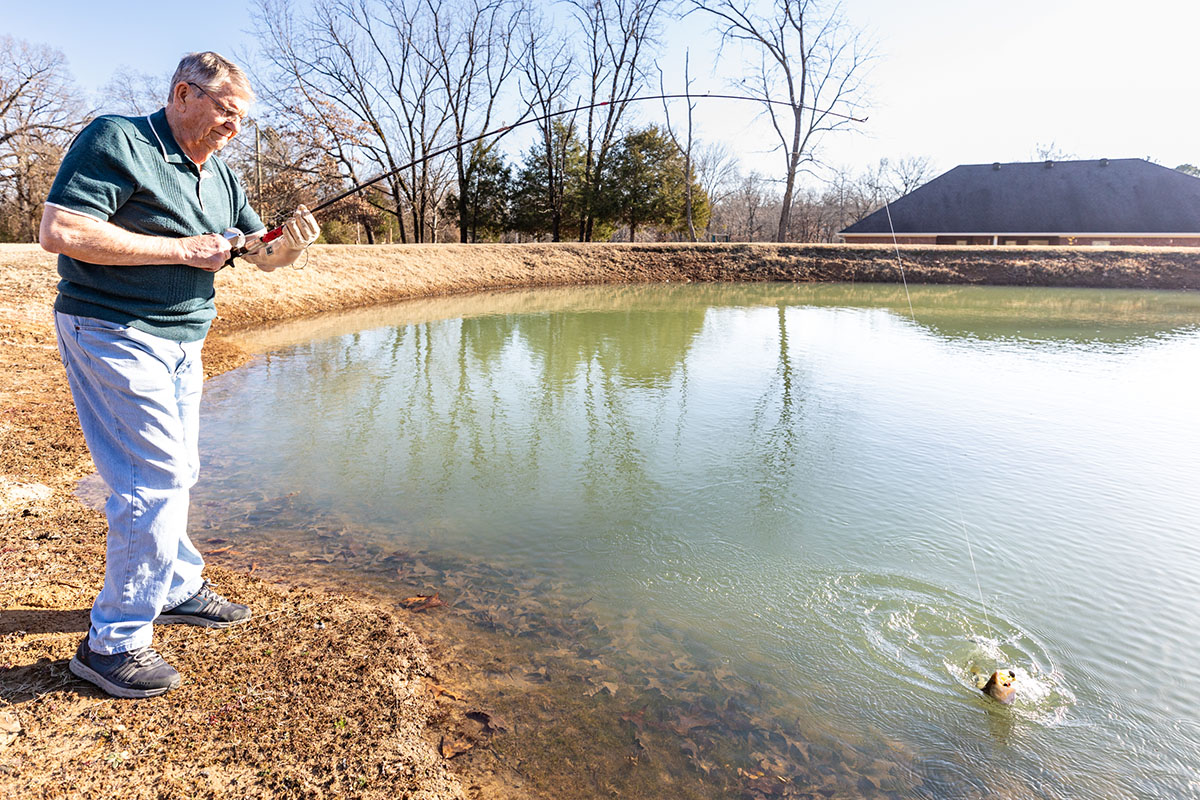
Since trying his prosthetic at home, Hickey has been able to use it for household tasks like cooking, professional interactions as a pastor at his church and – his favorite pastime – fishing. Perhaps most importantly, he can also now feel his wife’s hand.
“I’m extremely grateful,” Hickey says of his opportunity to participate in the study. “It has raised other possibilities for me that I never knew would exist. And I never knew that I would feel anything again. There’s no way to describe what it’s like to feel something when you haven’t felt it for more than 60 years.”
Thanks to his new neuroprosthetic system, Hickey can now feel the touch of his wife’s hand. Watch “Short Takes: Restoring Touch” for more on his story.
 The University of Arkansas and The Institute for Integrative and Innovative Research
(I³R) thank clinical trial participants, such as Mr. Hickey, for their role in advancing
innovation and industry partners, such as Cochlear, TASKA Prosthetics, and Snell Prosthetics
& Orthotics, whose expertise is integral to innovating safe, reliable, deployable
medical technologies.
The University of Arkansas and The Institute for Integrative and Innovative Research
(I³R) thank clinical trial participants, such as Mr. Hickey, for their role in advancing
innovation and industry partners, such as Cochlear, TASKA Prosthetics, and Snell Prosthetics
& Orthotics, whose expertise is integral to innovating safe, reliable, deployable
medical technologies.
Research supported by the U.S. National Institute of Biomedical Imaging and Bioengineering (NIBIB; R01 EB023261) and U.S. Army Medical Research Acquisition Activity (W81WXH1910839) to Principal Investigators Profs. James Abbas and Ranu Jung.